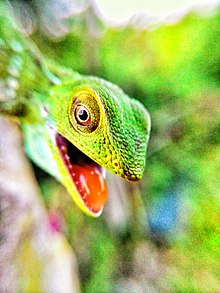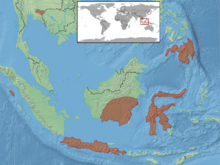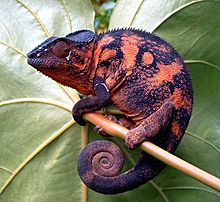Bunglon
| Bunglon | |
|---|---|

| |
| Klasifikasi ngèlmiah | |
| Karajan: | Animalia |
| Filum: | Chordata |
| Klas: | Reptilia |
| Ordho: | Squamata |
| Subordho: | Iguania |
| Famili: | Agamidae |
| Génus: | Bronchocela |
| Spésies: | B. jubata |
| Jeneng binomial | |
| Bronchocela jubata A.M.C. Duméril & Bibron, 1837 | |

| |
| Sinonim | |
Bunglon ya iku aran khusus kanggo manèka warna jinis kadal/bengkarung sing nduwèni kèmampuan kanggo ngganti werna kulit. Umumé, istilah "bunglon" digunakaké kanggo nyebut kadal saka suku Chamaeleonidae lan sawatara spèsiès saka suku liya, kaya ta saka Agamidae .[3]
Istilah ing basa Inggris ya iku Chameleon utawa Chamaeleon.[4][5][6] Nanging, istilah ing basa Inggris luwih kerep digunakaké kanggo nyèbut suku Chamaeleonidae. Chameleons nyebar ing sakiwa-tengené Afrika, Semenanjung Arab, Asia Kidul, menyang Nusantara. Ing Indonesia waé, istilah bunglon digunakaké kanggo nyèbut sawatara spèsiès gèn Bronchocela Sp., kaya ta mane chameleons.[7]
Pambuka
[besut | besut sumber]Hampir kabèh jinis bunglon duwé kèmiripan lan sifat fisik ing ngisor iki:[8]
- Ndas kanthi wangun sudut
- Kulit kasar
- Kelopak mata gedhé
- Bisa ngganti werna
Ganti Wèrna lan Mèkanisme
[besut | besut sumber]Istimèwané bunglon iki bisa ngganti wèrna (uga bisa kombinasi warna) kulit njabané. Saben jinis bunglon duwé sethithik sawatara werna dhasar saka ijo peteng, ijo enom, kuning, abang, oranye, coklat, abu-abu, jambon, sian, lan wungu. Sawetara spèsiès uga duwé kombinasi werna kasebut. Iki nggawé chameleons salah siji klompok kadal kang paling warna-warni ing donya.[9]
Mekanismé owahé warna disebabaké dèning zat nanocrystal ing permukaan kulit kang bisa ngèmot sinar. Werna sinar kang mantul ditemtokaké dèning ruang dinamis antarané nanocrystal. Uga ngetutaké werna pigmèn asli saka kulit Chameleons kang katon dideleng mripat manungsa utawa kèwan liyané kang ndeleng bunglon. Dadi, kombinasi werna lan werna kulit bunglon sing bisa katon ing sawayah-wayah bisa ganti.[9]
Fungsi werna
[besut | besut sumber]Chameleons ngganti warna kulit kanggo nyamaraké awaké karo lingkungané, yaiku kanthi ngganti werna kulit kasebut menyang warna ing ngendi dhèwèké ngadeg utawa obyek ing sacedhaké. Nanging, bunglon uga ngganti werna kulit kanggo nuduhaké rèaksi marang owahé suhu utawa intènsitas sinar ing sakubengé utawa kanggo nampilaké swasana ati. Biasané saben spèsiès nduwèni tujuan kanggo ngganti werna kulit kang beda. Owahan saka werna ireng uga digunakaké bunglon lanang nalika ana bunglon liyané ing wilayahé utawa kanggo nyedhaki bunglon wadon nalika musim kawin. Ing kasus loro bunglon lanang, kombinasi werna sing padhang minangka tandha yèn bunglon wis nduwèni kakuasan ing panggonan kasèbut, nalika kombinasi werna sing kurang alus minangka tandha yèn dhèwèké nyèrah.[10][11]
Liyane
[besut | besut sumber]Ing jinis Chamaeleonidae, nduwèni kaistimèwaan liyané ya iku bola mata kang bisa muter kanthi ngadhep ngarep, sisih, munggah, mudhun, bali, kanthi rotasi 360 °. Chameleons uga duwé panyawangan sing cètha. Kajaba iku, sapérangan spèsiès duwé ilat kang dawa banget. Ilat iki digunakaké kanggo nyekel serangga kang lumaku utawa ana ing ngarepé. Panganan utama saka bunglon ya iku serangga. Bunglon nyèkèl serangga kanthi mbukak cangkèmé lan némpelaké ilat kang dawa kanthi lèngket menyang targèt, banjur serangga kasebut menyang ilat bunglon kang banjur ditarik bali menyang cangkèmé. Jarak saka ilat bunglon ya iku loro pertelu dawané awaké. Sawetara jinis malah duwe ilat kang luwih dawa tinimbang total dawané awak.[12][13]
Galeri
[besut | besut sumber]-
Malagasy bigam ( Furcifer oustaleti )
-
Indian Chameleon ( Chamaeleo zeylanicus )
-
Chameleon Jackson ( Trioceros jacksonii )
-
Meller Chameleon ( Trioceros melleri )
-
Chameleon Panther ( Furcifer pardalis )
-
Mane Chameleon ( Bronchocela jubata )
-
Green crested chameleon ( Bronchocela cristatella )
Klasifikasi
[besut | besut sumber]Suku Chamaeleonidae
[besut | besut sumber]- Archaius Gray, 1865
- Bradypodion Fitzinger, 1843
- Brookesia Grey, 1865
- Calumma Gray, 1865
- Chamaeleo Laurenti, 1768
- Furcifer Fitzinger, 1843
- Kinyongia Tilbury, Tolley & Branch, 2006
- Nadzikambia Tilbury, Tolley & Branch, 2006
- Palleon Glaw, Hawlitschek & Ruthensteiner, 2013
- Rhampholeon Günther, 1874
- Rieppeleon Matthee, Tilbury & Townsend, 2004
- Trioceros Swainson, 1839
Suku Agamidae
[besut | besut sumber]- Bronchocela Kaup, 1827
- Gonocephalus chamaeleontinus (Laurenti, 1825) - Bunglon alas
Rujukan
[besut | besut sumber]- ↑ Ineich I, Hallermann J (2010). "Bronchocela jubata". IUCN Red List of Threatened Species. IUCN. 2010: e.T170378A6772283. doi:10.2305/IUCN.UK.2010-4.RLTS.T170378A6772283.en.
- ↑ Masalah sitiran: Tenger
<ref>ora trep; ora ana tèks tumrap refs kanthi jenengRDB - ↑ Glaw, F. (2015). "Taxonomic checklist of chameleons (Squamata: Chamaeleonidae)". Vertebrate Zoology. 65 (2): 167–246.
- ↑ chamaeleon. Charlton T. Lewis lan Charles Short. A Latin Dictionary ing Perseus Project.
- ↑ Cithakan:LSJ.
- ↑ Cithakan:LSJ.
- ↑ https://id.wikipedia.org/wiki/Bunglon_surai
- ↑ Klaver, C.; Böhme, W. (1986). "Phylogeny and classification of the Chamaeleonidae (Sauria) with special reference to hemipenis morphology". Bonner Zoologische Monographien. 22: 1–64.
- ↑ a b Chameleons. National Geographic Explorer
- ↑ Stuart-Fox, D.; Moussalli, A. (2008). "Selection for Social Signalling Drives the Evolution of Chameleon Colour Change". PLoS Biology. 6 (1): e25. doi:10.1371/journal.pbio.0060025. PMC 2214820. PMID 18232740.
- ↑ Harris, Tom. "How Animal Camouflage Works". How Stuff Works. Dibukak ing 2006-11-13.
- ↑ Ott, M.; Schaeffel, F.; Kirmse, W. (1998). "Binocular vision and accommodation in prey-catching chamaeleons". Comparative Physiology A. 182 (3): 319–330. doi:10.1007/s003590050182.
- ↑ Higham, T. E.; Anderson, C. V. (2014), "Function and adaptation of chameleons", ing Tolley, K. A. (èd.), The Biology of Chameleons, Berkeley, CA: University of California Press, kc. 63–83
- Anderson, C. V.; Deban, S. M. (2010). "Ballistic tongue projection in chameleons maintains high performance at low temperature". Proceedings of the National Academy of Sciences of the United States of America. 107 (12): 5495–5499. Bibcode:2010PNAS..107.5495A. doi:10.1073/pnas.0910778107. PMC 2851764. PMID 20212130. Anderson, C. V.; Deban, S. M. (2010). "Ballistic tongue projection in chameleons maintains high performance at low temperature". Proceedings of the National Academy of Sciences of the United States of America. 107 (12): 5495–5499. Bibcode:2010PNAS..107.5495A. doi:10.1073/pnas.0910778107. PMC 2851764. PMID 20212130. Anderson, C. V.; Deban, S. M. (2010). "Ballistic tongue projection in chameleons maintains high performance at low temperature". Proceedings of the National Academy of Sciences of the United States of America. 107 (12): 5495–5499. Bibcode:2010PNAS..107.5495A. doi:10.1073/pnas.0910778107. PMC 2851764. PMID 20212130. Anderson, C. V.; Deban, S. M. (2010). "Ballistic tongue projection in chameleons maintains high performance at low temperature". Proceedings of the National Academy of Sciences of the United States of America. 107 (12): 5495–5499. Bibcode:2010PNAS..107.5495A. doi:10.1073/pnas.0910778107. PMC 2851764. PMID 20212130. Anderson, C. V.; Deban, S. M. (2010). "Ballistic tongue projection in chameleons maintains high performance at low temperature". Proceedings of the National Academy of Sciences of the United States of America. 107 (12): 5495–5499. Bibcode:2010PNAS..107.5495A. doi:10.1073/pnas.0910778107. PMC 2851764. PMID 20212130. Anderson, C. V.; Deban, S. M. (2010). "Ballistic tongue projection in chameleons maintains high performance at low temperature". Proceedings of the National Academy of Sciences of the United States of America. 107 (12): 5495–5499. Bibcode:2010PNAS..107.5495A. doi:10.1073/pnas.0910778107. PMC 2851764. PMID 20212130. Anderson, C. V.; Deban, S. M. (2010). "Ballistic tongue projection in chameleons maintains high performance at low temperature". Proceedings of the National Academy of Sciences of the United States of America. 107 (12): 5495–5499. Bibcode:2010PNAS..107.5495A. doi:10.1073/pnas.0910778107. PMC 2851764. PMID 20212130.
- Herrel, A.; Meyers, J. J.; Nishikawa, K. C.; De Vree, F. (2001). "Morphology and histochemistry of the hyolingual apparatus in chameleons". Journal of Morphology. 249: 154–170. doi:10.1002/jmor.1047. PMID 11466743. Herrel, A.; Meyers, J. J.; Nishikawa, K. C.; De Vree, F. (2001). "Morphology and histochemistry of the hyolingual apparatus in chameleons". Journal of Morphology. 249: 154–170. doi:10.1002/jmor.1047. PMID 11466743. Herrel, A.; Meyers, J. J.; Nishikawa, K. C.; De Vree, F. (2001). "Morphology and histochemistry of the hyolingual apparatus in chameleons". Journal of Morphology. 249: 154–170. doi:10.1002/jmor.1047. PMID 11466743. Herrel, A.; Meyers, J. J.; Nishikawa, K. C.; De Vree, F. (2001). "Morphology and histochemistry of the hyolingual apparatus in chameleons". Journal of Morphology. 249: 154–170. doi:10.1002/jmor.1047. PMID 11466743.
- Database Reptil : Familia Agamidae









